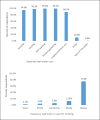Private-well stewardship among a general population based sample of private well-owners
- PMID: 28605871
- PMCID: PMC5662198
- DOI: 10.1016/j.scitotenv.2017.05.284
Private-well stewardship among a general population based sample of private well-owners
Abstract
Private well stewardship, including on-going testing and treatment, can ensure private well users are able to maintain source-water quality and prevent exposures to potentially harmful constituents in primary drinking water supplies. Unlike municipal water supplies, private well users are largely responsible for their own testing and treatment and well stewardship is often minimal. The importance of factors influencing regular testing, and treatment behaviors, including knowledge, risk perception, convenience and social norms, can vary by geography and population characteristics. The primary goals of this study were to survey a general statewide population of private well users in Wisconsin in order to quantify testing and treatment patterns and gather data on motivations and barriers to well stewardship. The majority of respondents reported using and drinking well water daily but only about one half of respondents reported testing their wells in the last ten years and of these, only 10% reported testing in the last 12months. Bacteria and nitrates were contaminants most often tested; and, a private laboratory most often conducted testing. The most commonly reported water treatment was a water softener. Living in a particular geographic region and income were the most significant predictors of water testing and treatment. Iron and hardness, which influence water aesthetics but not always safety, were the most commonly reported water quality problems. Health concerns or perceived lack thereof were, respectively, motivators and barriers to testing and treatment. Limited knowledge of testing and treatment options were also identified as barriers. Results confirm previous findings that well stewardship practices are minimal and often context specific. Understanding the target population's perceptions of risk and knowledge are important elements to consider in identifying vulnerable populations and developing education and policy efforts to improve well stewardship.
Keywords: Prevention; Private well; SHOW; Testing; Treatment; Well stewardship.
Copyright © 2017 Elsevier B.V. All rights reserved.
Figures





Similar articles
-
Understanding stewardship behaviour: factors facilitating and constraining private water well stewardship.J Environ Manage. 2011 Apr;92(4):1104-14. doi: 10.1016/j.jenvman.2010.11.017. Epub 2010 Dec 24. J Environ Manage. 2011. PMID: 21185114
-
User experience of point-of-use water treatment for private wells in North Carolina: Implications for outreach and well stewardship.Sci Total Environ. 2022 Feb 1;806(Pt 1):150448. doi: 10.1016/j.scitotenv.2021.150448. Epub 2021 Sep 21. Sci Total Environ. 2022. PMID: 34563909
-
Description of calls from private well owners to a national well water hotline, 2013.Sci Total Environ. 2016 Feb 15;544:601-5. doi: 10.1016/j.scitotenv.2015.11.141. Epub 2015 Dec 9. Sci Total Environ. 2016. PMID: 26674689 Free PMC article.
-
Factors influencing perceptions of private water quality in North America: a systematic review.Syst Rev. 2019 May 10;8(1):111. doi: 10.1186/s13643-019-1013-9. Syst Rev. 2019. PMID: 31077249 Free PMC article.
-
Strategies to Improve Private-Well Water Quality: A North Carolina Perspective.Environ Health Perspect. 2017 Jul 7;125(7):076001. doi: 10.1289/EHP890. Environ Health Perspect. 2017. PMID: 28728142 Free PMC article. Review.
Cited by
-
Development and Validation of an Environmental Health Literacy Assessment Screening Tool for Domestic Well Owners: The Water Environmental Literacy Level Scale (WELLS).Int J Environ Res Public Health. 2019 Mar 11;16(5):881. doi: 10.3390/ijerph16050881. Int J Environ Res Public Health. 2019. PMID: 30862003 Free PMC article.
-
Uranium and arsenic unregulated water issues on Navajo lands.J Vac Sci Technol A. 2020 May;38(3):031003. doi: 10.1116/1.5142283. Epub 2020 Mar 20. J Vac Sci Technol A. 2020. PMID: 32226218 Free PMC article.
-
Evaluating the effectiveness of community-informed resource dissemination at increasing knowledge and testing rates among private well water owners in a statewide population.J Environ Manage. 2025 Jan;373:123671. doi: 10.1016/j.jenvman.2024.123671. Epub 2024 Dec 22. J Environ Manage. 2025. PMID: 39718062 Free PMC article.
-
Methods for Estimating Locations of Housing Units Served by Private Domestic Wells in the United States Applied to 2010.J Am Water Resour Assoc. 2021 Oct;57(5):1-16. doi: 10.1111/1752-1688.12937. J Am Water Resour Assoc. 2021. PMID: 34987281 Free PMC article.
-
Dissolved Uranium and Arsenic in Unregulated Groundwater Sources - Western Navajo Nation.J Contemp Water Res Educ. 2020 Apr;169(1):27-43. doi: 10.1111/j.1936-704x.2020.03330.x. Epub 2020 Jun 1. J Contemp Water Res Educ. 2020. PMID: 34790284 Free PMC article.
References
-
- Bureau, U. S. C. American Housing Survey for the United States: 2007. U.S. Government Printing Office; Washington, D.C: 2008.
-
- Desimone LA, National Water-Quality Assessment Program (U.S.) Quality of water from domestic wells in principal aquifers of the United States, 1991–2004. U.S Dept of the Interior, U.S. Geological Survey; Reston, Va: 2009. p. xi, 127.
-
- Fox MA, Nachman KE, Anderson B, Lam J, Resnick B. Meeting the public health challenge of protecting private wells: Proceedings and recommendations from an expert panel workshop. The Science of the total environment. 2016;554–555:113–8. - PubMed
-
- Frederick L, VanDerslice J, Taddie M, Malecki K, Gregg J, Faust N, Johnson WP. Contrasting regional and national mechanisms for predicting elevated arsenic in private wells across the United States using classification and regression trees. Water research. 2016;91:295–304. - PubMed
-
- Resources, W. D. o. N. Wells. http://dnr.wi.gov/topic/wells/ (5/5/2017)
MeSH terms
Grants and funding
LinkOut - more resources
Full Text Sources
Other Literature Sources

